Page
Last Updated:
Tuesday, 09 December 2025 17:24 EDT, © 2022, 2023, 2024, 2025

Analysis:
The characters in the Persistence of Vision series invent a
Hilbert space of literature characteristics, so it seemed appropriate to use
that concept on my novels (and my scientific books). Each
dimension in this literary Hilbert space spans the values of a particular
descriptive variable, such as Flesch-Kincaid Grade Level and action scenes per
5000 words of text. The concept is that similar works should have similar
dimensional-values - or directly explainable differences, such as the number of
words in a short story versus the number in a novel.
The entire Hilbert space can be contained in a SAS JMP file;
however, visualizing dozens of dimensions is difficult. Fortunately, JMP
provides a 3-D tool that allows for rotation of the visualization. I've
provided four salient views that I rotated so that their 2-D renderings provide
some information.
Size
The size metrics include page count, word count, number of
chapters, and number of figures.
Overall, the novels average 340 pages, with the Dark Energy series being
slightly longer, averaging 360 pages, and the Force-Field series being
shorter at 306 pages. The word count average is 108,000 and is fairly
consistent across the series, with a standard deviation of 11,000 words.
The number of chapters range from 17 to 26, with an average of 20.9. The
number of figures has the largest variation, ranging from 1 to 20 per novel;
however, most have 3-7 figures.
Content
The content variables are science, religion, sexy scenes,
action, travel, business, and figures. The occurences and intensity of
each of these are divided by the word count for each novel and converted to
per-5000-word metrics.
The first scatterplot illustrates the basic concept with four groups of
books. To the lower right are my scientific books, as expected, they show
some variation in the Science per 5000K words axis, but are all close to zero on
the sexy-scene and religion axes. The second group, at the top of the
figure are the religious books. They are high on the religious axis and
low on the other two axes. I invented a third group to span the space,
which is very high on the sexy axis, but low on the other two axes. In the
middle are the science fiction novels.
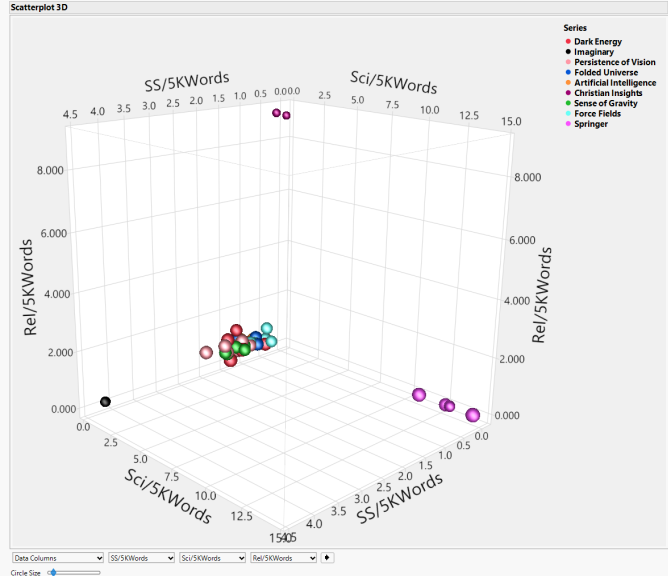
The second scatterplot is the same as the first, but with the
axes restricted to the values exhibited by the novels. It
shows that the novels have some spread in this Hilbert space but that
there are some commonalities with each of the six series that are shown.
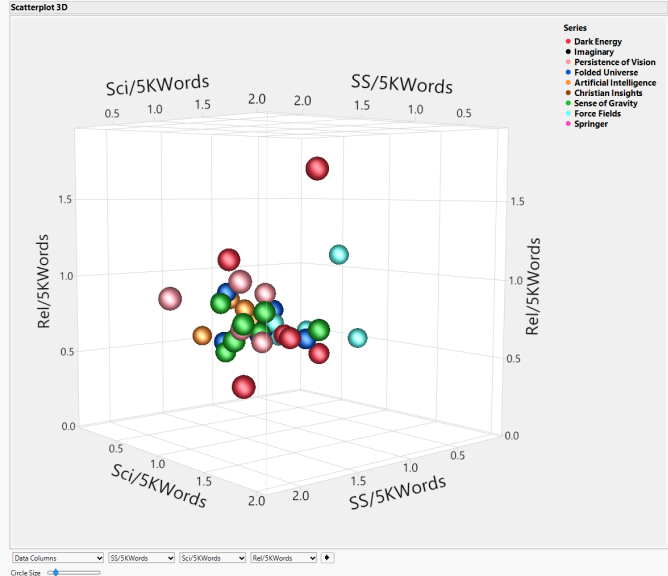
The data are
color-coded by series. The Dark Energy and Force-Field series show more
spread in both the sexy scenes and the religion dimensions.
The third scatterplot compares the values in the action,
travel, and business dimensions. There are differences in all three
dimensions.

The final content dimension, figures per 5000 words, is not
displayed. The Dark Energy and Sense of Gravity series contain books with
significantly more figures than their series averages and more than in the Persistence
of Vision series.
The figure below shows that on a per 5000 word basis,
sexy-scenes, science, and religion provide the most content of the books.
This figure does include figures per 5K words for comparison.
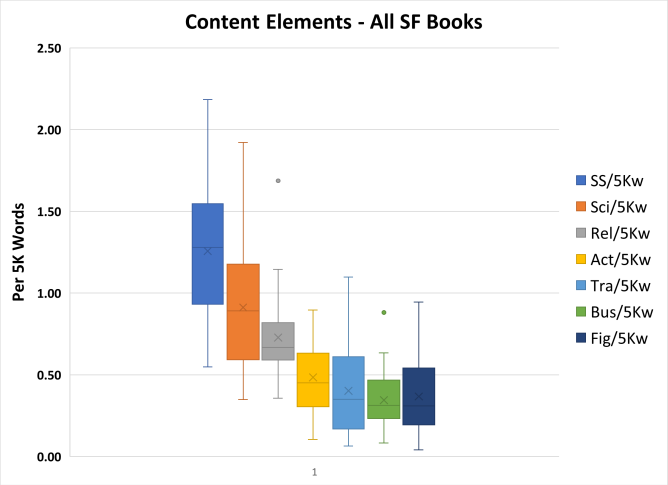
The figure below compares the averages within each series for
the content variables. As you can see, the Dark Energy, Persistence of
Vision, and Sense of Gravity series have more sexy scenes and science per 5K
words than the other three series. There is overlap when you look at the
books, but on average, there is separation. In the other content
variables, there is no clear separation.
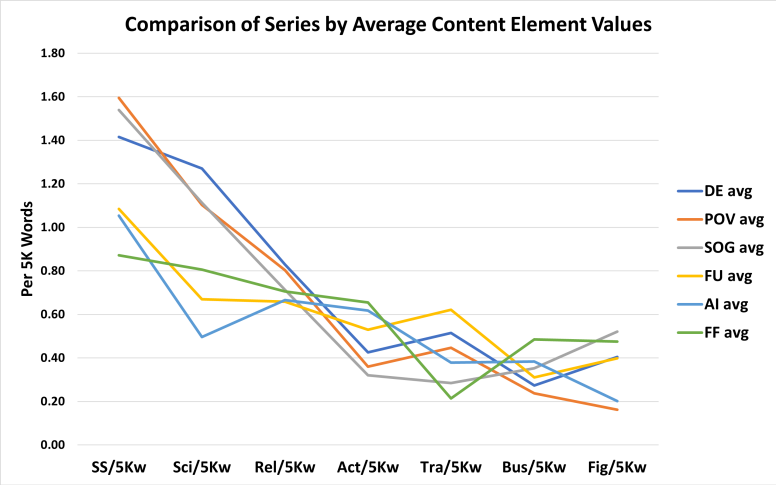
Style
The style variables are dialog per 5000 words, reading grade
level, and passive sentence fraction. As above, the data are coded by
series in the scatterplot. The Dark Energy novels are written at a
slightly higher grade level, 7.5, than the other five series, 6.7, 6.5, 6.3,
6.3, and
5.8.
The AI and Persistence of Vision series, on average, have more dialog and the Dark
Energy and Sense of Gravity series have less, while the reverse is true with regard to passive
sentences.
However, overall, the averages in all three variables are close.
Individually, the novels show that larger dialog values are correlated with
lower grade levels and a smaller proportion of passive sentences; whereas, lower
dialog values go with higher grade levels and more passive sentences.
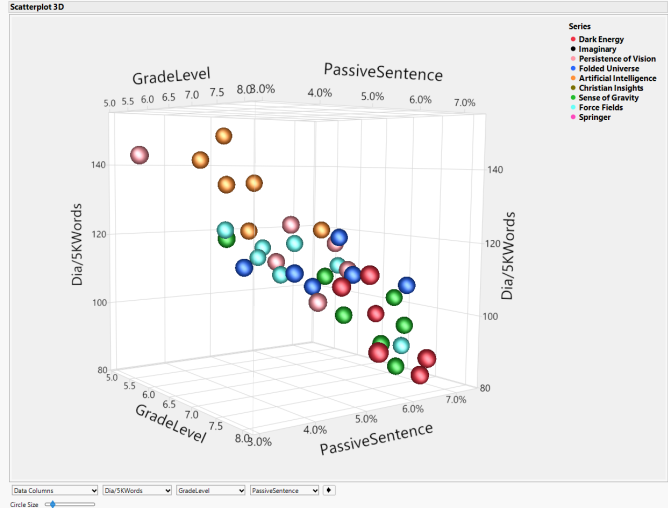
I also experimented with using the date of writing each novel to see if there
were any significant changes as I matured as a writer. I didn't find
anything dramatic, so none of that is displayed here.
Conclusion
In some dimensions, there are differences among the series;
however, they are generally similar. The 3-D scatterplots have a reference
in the legend to the Springer-published scientific books; however, they aren't
shown in most of the views, as they are widely separated from the science
fiction data points. Thus, the Hilbert space concept can produce the
desired differentiation among literary works, clumping scientific works in one
volume of the space and science fiction in another. Further
differentiation within these novels would be possible. For example,
separating the different sciences that are used would separate the series and
some intra-series separation. (Anthropology is strongly used in the latter
three novels of the Dark Energy series, but not in the first three - or in the
next two series, for that matter. But anthropology is used in the fourth
series.)
Similarly, identifying the science-fictional theme would allow
differentiation - and, if combined with analyses of other SF works - would allow
for clumping along that set of dimensions.
-
Dark Energy: telepathy and faster than
light communications.
-
Persitence of Vision: mental control of quantum
effects.
-
Sense of Gravity: a space opera based on
artificial gravity.
-
Folded Universe: adventure based on portals
through a fifth dimension.
-
Artificial Intelligence: artificial intelligence.
-
Force-Fields: a space opera based on generating
force-fields through manipulating tensor components.
This analysis serves no purpose other than being fun.
However, there are people who do literary scholarship in SF and they might find
the technique to be useful.
 Return to Dean Hartley Science Fiction
Return to Dean Hartley Science Fiction
 Return to Dr. Dean S. Hartley III Entrance.
Return to Dr. Dean S. Hartley III Entrance.









Return to Dean Hartley Science Fiction
Return to Dr. Dean S. Hartley III Entrance.